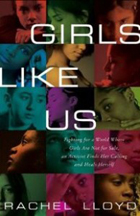2/27/2012

The first time I heard Rachel Lloyd speak was in 2005, the year of the 70th Annual Academy Awards. "It's Hard Out Here for a Pimp" had won for the best song of the year. Whenever I complained about that song being showcased, people would tell me to "lighten up." Yet when Lloyd stepped up to address the issue of human trafficking, she brought up that song, and the disconnect between reality and what the Hollywood version of life on the street entails.
Since then, while covering the topic of human trafficking, I have seen Lloyd talk at numerous events and panels. I have called her up for quotes and insights, such as the time football starLawrence Taylor was arrested. I had needed to get a lucid response on why the media was portraying an under-age trafficked girl as a "hooker."
Lloyd always speaks the truth to power. It may be to a New York City police commissioner, or a Manhattan audience learning for the first time that 13-year-old African-American girls in Bedford-Stuyvesant, Brooklyn are being bought and sold. Lloyd frequently notes that they are part of an estimated 200,000-300,000 adolescents who are at risk for commercial sexual exploitation in the United States annually.
Consequently, it was no surprise to me that the memoir Lloyd had penned, Girls Like Us: Fighting for a World Where Girls Are Not for Sale, an Activist Finds Her Calling and Heals Herself, would be a tough, gritty and brutally honest account. Lloyd traces how a difficult childhood led to a hair-raising journey that encompassed risk, recruitment, and violent abuse--to breaking free from sexual exploitation...and ultimately healing. She now is a top activist in the anti-trafficking movement.
Finding her purpose in working with girls "in the life," Lloyd connects to those in crisis based on shared experiences, understanding without judgment, and respect. Founding Girls Educational and Mentoring Services (GEMS) in 1998, Lloyd went back to school to attain her GED, going on to receive a Bachelors degree in Psychology from Marymount Manhattan College and a Masters in Applied Urban Anthropology from the City College of New York. She has racked up numerous awards for her work, all while "owning her experience."
Girls Like Us presents a dual story thread. One is Lloyd's personal narrative; the other is a primer on what trafficked American girls are up against. Lloyd outlines the factors that make girls vulnerable, examines how they are sexually exploited, and discusses the role of pimps, johns, and cops in the equation. The inherent difficulties of overcoming the trauma of sexual servitude often mimic the symptoms of Stockholm syndrome and Post Traumatic Stress Disorder (PTSD).
Lloyd breaks down one fallacy after another, many unfortunately believed by social workers, law enforcement officials, and those making decision calls in the judicial system. If misconceptions could start to be addressed, perhaps a real awareness toward new solutions could be innovated.
There is so much that needs to change, and Lloyd points out the problems with crystal clarity. One of her frequent talking points is the statistic that the estimated median age of entry into the commercial sex industry occurs between the ages of 12 and 14. Defining the difference between an "exploited child and a prostitute" is a full time endeavor. She explains that "leaving the life takes practice," and that girls need to have the unfailing support of a person who will not "give up on them." Most important to note are the socioeconomic causes, that for some baffling reason appears more comprehensible when they occur in foreign countries, but which are insufficiently grasped on our own national turf.
Lloyd posits that too often the wrong questions are asked. Instead of taking a facile approach to a girl's situation with the query, "Why doesn't she just leave?"--Lloyd suggests an examination of the impact of poverty, homelessness, and neglect, along with "race and class factors."
With over 500,000 children in New York City living in poverty, the risk factor is high. A 2007 study showed that 75 percent of sexually exploited and trafficked children in New York City were in foster care at some point. Connect the dots to an ineffective support system, and you end up with a "policy that blames the victim."
For police who don't understand that captivity isn't an issue of being physically tied and bound, it can be frustrating to explain the depths of a "trauma bond" in an existence predicated on terror. Leaving the life and making the transition is difficult. As Lloyd says, "Healing is a messy, complicated process that's rarely linear." It doesn't help that society--even those tasked with supporting victims--often relay the message that the girl's "exploitation was their choice," leaving them with a burden of blame and shame.
One of the major challenges is the need to reframe not only attitudes, but also language. The United Nations and UNICEF have adopted the term commercially sexually exploited child/youth to reference those who are underage. New terminology will help grow novel thinking. Once assimilated into the collective mindset, a change can start to be reflected in the media and popular culture. As Lloyd emphasizes, most of America didn't have trouble understanding the trauma of Elizabeth Smart. But when you shift from her story to a 14-year-old girl of color in the Bronx, the reaction is totally different.
Girls Like Us puts it all out there -- no holds barred. In addition to the contribution that Lloyd has made with her book filled with detailed veracity and visceral punch, she has left the public with nothing to hide behind.
There can no longer be the question, "Who knew?"
Fight child exploitation and get involved with organizations such as GEMS.
Girls Like Us comes out in paperback on February 28, 2012
This article originally appeared on the website mgyerman.com
Follow Marcia G. Yerman on Twitter: www.twitter.com/mgyerman


No comments:
Post a Comment